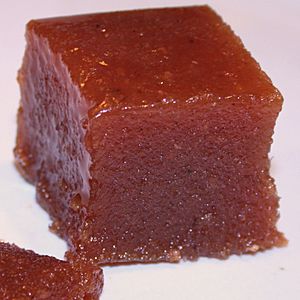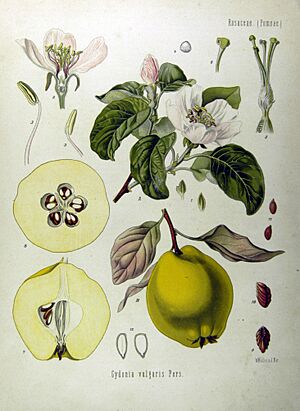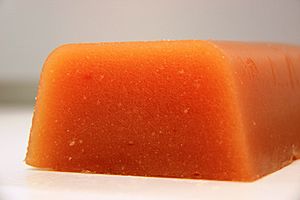Quince cheese facts for kids
 |
|
| Type | Jelly |
|---|---|
| Main ingredients | Quince, sugar |
Quince paste (also called quince cheese) is a sweet, thick jelly. It is made from the pulp of the quince fruit. This tasty treat is popular in many countries around the world.
It is especially common in the Iberian Peninsula (Spain and Portugal). In Spanish, it is known as dulce de membrillo. In Portuguese, it is called marmelada. This firm, sweet, reddish paste comes from the quince fruit (Cydonia oblonga). It is also very popular in countries like Brazil, France, Chile, Argentina, Mexico, Italy, and Turkey.
Contents
Discovering the History of Quince Paste
The idea for quince paste is very old. Ancient Roman cookbooks, like one by Apicius, show recipes for cooking quince with honey. This means people have enjoyed quince for a very long time!
The English word "marmalade" actually comes from the Portuguese word marmelada. This word originally meant "quince preparation." It was used to describe quince paste or quince jam. Today, "marmalade" usually means a jelly made from citrus fruits with pieces of fruit peel inside.
How to Make Quince Paste
Quince paste is made using quince fruits. First, the fruit is peeled and the core is removed. Then, it is cooked with a little water and a lot of sugar. For every kilogram of quince pulp, about 500 to 1000 grams of sugar are used.
Cooking it in a pressure cooker makes it a light brick color. If you cook it longer in a regular pot, it turns a darker brick color. After cooking, the mixture is left to set for a few days. It becomes a firm paste that holds its shape. It tastes sweet but can be a little bit tart, depending on how much sugar is added.
Quince jelly is a bit different. It is made from the skins and cores of the quince fruit. These parts are cooked until they are much smaller. The liquid is then strained. Sugar is added to this liquid, and it is boiled again until it becomes a jelly.
Quince paste is often sold in blocks. You can cut it into thin slices and spread it on toast or sandwiches. It is often eaten for breakfast or as a snack. Many people enjoy it with different types of cheese, like Manchego from Spain or Serra da Estrela cheese from Portugal. It is also used as a filling for pastries.
Quince Paste Around the World

In countries like Spain, Argentina, Mexico, and Chile, quince is cooked into a reddish, firm paste called dulce de membrillo. In some of these places, similar pastes are made using other fruits or vegetables. These can include sweet potatoes, squash, apricots, figs, or guavas.
The pastafrola is a sweet tart popular in Argentina, Uruguay, and Paraguay. It is usually filled with quince paste. In Argentina and Uruguay, eating a slice of quince paste with a slice of soft cheese is a very popular dessert. In Argentina, it is called vigilante. In Uruguay, it is known as Martín Fierro, named after a famous folk hero.
In France, "quince paste" or pâte de coing is a part of the Christmas traditions in Provence. It is one of the thirteen desserts served during Christmas celebrations.
In countries like Serbia, Hungary, and Croatia, quince paste is also a common sweet treat. It is called kitn(i)kes in some areas. In Hungary, it is known as birsalmasajt. Sometimes, lemon zest, cinnamon, or walnuts are added to it. A botanist named Péter Melius Juhász mentioned quince paste as early as 1578, noting its health benefits.
In some regions, like Vojvodina in Serbia, people might add finely grated walnuts, hazelnuts, or pumpkin seeds. Sometimes, honey is used instead of some of the sugar.
See also
 In Spanish: Dulce de membrillo para niños
In Spanish: Dulce de membrillo para niños



